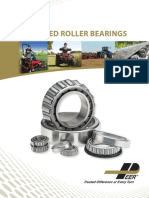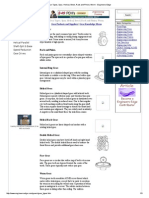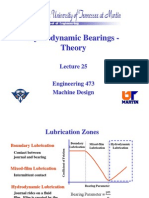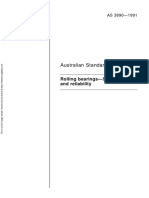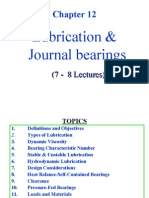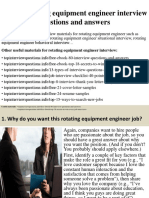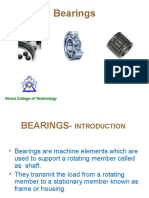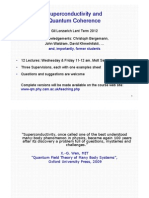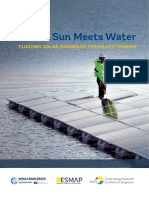Bearings
Bearings
Uploaded by
gaurav tiwariCopyright:
Available Formats
Bearings
Bearings
Uploaded by
gaurav tiwariOriginal Description:
Copyright
Available Formats
Share this document
Did you find this document useful?
Is this content inappropriate?
Copyright:
Available Formats
Bearings
Bearings
Uploaded by
gaurav tiwariCopyright:
Available Formats
Contents
Bearings
Bearings Classification
Loads on Bearings
Rolling elements bearings
Ball bearings
Roller bearings
Needle bearings
Linear bearings
Thrust bearings
Sliding bearing
Magnetic bearings
Application of bearings
Bearing mounting
Bearing Selection
Each type of bearing has characteristic properties which make it
particularly suitable for certain applications. The main factors to be
considered when selection the correct type are:
Available Space
Magnitude and direction of load
(radial, axial, or combined)
Misalignment and dismounting procedures
Precision Required
Noise factor
Internal Clearance
Materials and cage design
Bearing Arrangement
Seals
Bearings
Provides support for rotating machine elements
Bearings
Bearings Classification
Bearings for Rotary
Motion
Magnetic Bearings
Sliding Bearings
(Fluid film bearings)
Rolling Elements
Roller Ball Needle
C
Y
LI
N
D
RI
C
A
T
a
p
e
r
B
a
r
r
e
l
Allocated Loads on Bearings
Ball Bearings
Radial and Axial loads
Roller Bearings
Radial and Axial loads
Needle Bearings
Only radial loads
Rolling Elements Bearings
Single row radial ball bearing
Good Radial Load
Moderate Axial Load
Very good speed
See the difference in the
curvature of the ball and the
race. (Point Contact)
Ball Bearings with shields
The shields are use to exclude dirt and foreign particles
Angular contact Bearings
Balls are inserted by thermally expanding
outer ring.
Can take greater axial load
Good Radial Loads
Good Axial loads
Good Speed
Double row ball Bearings
Good Radial
Loads
Poor Axial loads
Moderate Speed
Piece inner-ring ball bearings
Advantages:
The maximum complement
of balls makes for higher
load carrying capacity.
The very deep ball raceway
shoulder makes for high
thrust load capacity.
Thrust loads can be
handled in both directions.
Roller Bearings
Because of the line
contact, they can take
greater loads
They also have more
rolling resistance
Types of roller bearings
Cylindrical
Tapered
Barrel (Spherical)
Cylindrical roller bearings
Are used in applications like conveyer belt
rollers, where they must hold heavy radial loads.
Line contact to handle much greater loads than a
ball bearing.
Is not designed to handle much axial loading.
Very good Radial Loads
Poor Axial loads
Moderate to very good
Speed
Tapered roller bearings
Are used in car hubs, where they are
usually mounted in pairs facing opposite
directions so that they can handle thrust in
both directions.
Very good Radial Loads
Good Axial loads
Moderate Speed
Needle bearings(1/2)
Use large number of small diameter rollers
Usually there is no space between rollers
(needles). No cage required.
Very good Radial loads
No Axial loads
Poor to moderate speed
Linear bearings
Are used primarily where something needs to be moved along
a straight line with high accuracy. In other words, the object
needs to only translate in one direction, and possibly move
back to its starting position with high repeatability. The
implications for robotic pick-and-place are obvious, as are uses
for optical test fixturing and calibration.
Thrust bearings
Cylindrical roller
Spherical roller
Thrust Ball Bearings
Good Axial Loads
No Radial Loads
Poor Speeds
Ball thrust bearings
are mostly used for low-speed applications
No Radial Loads
Good Axial loads
Poor to Moderate Speed
Roller thrust bearings
1. They can support large thrust loads
2. They are often found in gear sets like car transmissions between
gears, and between the housing and the rotating shafts.
3. The helical gears used in most transmissions have angled teeth in
this causes a thrust load that must be supported by a bearing
Very good Axial Loads
No Radial Loads
Poor Speeds
Sliding Bearings (Fluid film bearings)
Fluid film bearings have no rolling elements
Lubricated by a film of liquid or gas which separate
moving member from the stationary member
The fluid (usually Oil) is circulated so that fresh, cool
oil is constantly entering the space between the
stationary and rotating pieces.
Sliding Bearings (Fluid film bearings)
Industrial machinery with high horsepower and high loads, such as:
steam turbines, centrifugal compressors, pumps and motors
Magnetic Bearings
Magnetic Bearings are operating in:
compressors, electric motors, pumps, turbo expanders, steam turbines, gas
turbines, centrifuges, etc.
Magnetic bearing systems represent a completely different approach to
the support of rotating equipment. (NON-CONTACTING TECHNOLOGY)
Magnetic bearings
Are a non-contacting technology
Negligible friction loss and no wear
Higher reliability
Enables previously unachievable surface speeds to be attained
Lubrication is eliminated
Conical Magnetic Bearings Developed for Active
Stall Control in Gas Turbine Engines
Magnetic Bearings for High Temperature
Smart Aero Engine
Bearing applications
Pumps
Gearboxes Mixers Wheels
Air Condition systems
Bearings in flight systems
Helicopter ball bearing
ball bearing
Tapered Roller bearing
Bearing Care Prior to Mounting
Store in original unopened pack ( rust Preventive
slush )
Handle the bearing with clean, dry hands and
with clean rage.
Keep bearing on clear paper and covered
Never use bearing as gauge.
Do not wash a new bearing ( protective coated
need not to be removed )
Mount bearing in dirt free space
Preparation for Mounting
Before mounting, all the necessary parts,
tools, equipment and data need to be at hand.
Refer recommended drawing & instruction
before hand.
Check & clean lining of all housings, shaft,
seal, and other component.
Hold the job firmly
Take measurement of components before
mounting & record for future reference.
Mount
Mount with sufficient press fit to avoid
creep(rotating load outer tight, shaft rotating
inner race tight)
Use mandrill, adopter, pusher (Threaded,
Hydraulic, Mechanical pressure) etc to mount
Mount or press tighter side race first
Ring, cage, rolling elements & seals should
receive direct blow
Press both races simultaneously if same fit on
both side
Take care of clearances mounted & unmounted
(designed for standard fit)
Thermal mounting
For large bearing heating is required to get
desired fit.
Heat the bearing about 150 to 250F.
Induction, oven heating preferred over oil
bath heating.
Housing heating is required if outer race is
tight by bulb etc.
reuse
Inspect after cleaning.
never spin a dirty bearing.
Use a small mirror & a dental type probe with a
rounded point to inspect race ways, cage &
rolling element.
Look for scratches, marks, streaks, cracks,
discolouration, mirror like surface
Carefully rotate & listen sound
Never wash a ZZ bearing these are lifetime sealed
Clean with light oil <SAE10
Lubrication
To prevent metal to metal contact, carry away
heat, prevent corrosion
Selected on the basis temperature, speed,
load, surrounding conditions
Methods: oil bath, oil picking rings, circulating
system, oil jet, oil mist(oil air mixture)
problems-Excessive heating
Excessive heating
1. Lubrication
2. Insufficient internal clearances
3. Improper bearing loading
4. Sealing condition
problems-Excessive noise
1. Metal to metal contact(too high temp, very
low speed, lack of lubrication, leakage, low
load, stiff lubrication)
2. contamination
3. looseness
4. Surface damage
5. rubbing
problems-Excessive vibration
1. Metal to metal contact(too high temp, very
low speed, lack of lubrication, leakage, low
load, stiff lubrication)
2. contamination
3. looseness
4. Surface damage
problems-Excessive shaft movement
1. looseness
2. Surface damage
3. Wrong design
4. Preloaded bearing(fit
problems-Excessive torque to rotate
1. Preloaded bearing(excessive fit, out of round
shaft, shaft material expand more)
2. Sealing drag(tight, misaligned, multiple seals,
not properly lubricated)
3. Surface damage
4. design
Bearing damage
Fatigue
Wear (abrasive, adhesive)
Corrosion (moisture, frictional)
Electrical erosion (excessive voltage, current
leakage)
Plastic deformation (overload, indentation,
from debris or by handling)
Fracture (forced, fatigue, thermal cracking)
Definitions
Fatigue a change in the material structure
caused by the repeated stresses developed in the
contacts between the rolling elements and
raceways.
Subsurface fatigue the initiation of micro-
cracks at a certain depth under the surface.
Surface initiated fatigue flaking that originates
at the rolling surfaces as opposed to subsurface.
Wear the progressive removal of material
Bearing Mounting
Bearing Mounting
Shaft/bearing bore has a light interference
fit.
Housing/outer race has a slight clearance fit.
(Check manufacturers catalog)
Match maximum permissible fillet radius.
Shaft or housing shoulders not to exceed
20% of diameter.
Typical bearing mounting
Other ways to locate bearings: retaining rings,
washers, screws, cotter pins, taper pins
Ball Bearing
Outer ring of one
bearing clamped
e.g. cover plate
bearing
free to float
Nuts clamp inner
ring to shaft
Shoulders
locate bearings
Bearing calculations - Lifetime
Dynamic load C is given by the manufacturer for a
specified lifetime (e.g. L= 106 cycles) and a probability
of survival, usually L The life (in millions of cycles) is
given by
L= [C/p]
K
(for steady load) where C is the rated Dynamic load
capacity and P is the load.
k is an empirical factor depending on the bearing: 3 for
ball bearings, 3.33 for roller bearings
Manufacturers Data
Vendors publish the
Basic Dynamic Load
rating (C) of a bearing
at an L10 life of
1 million cycles.
Stress Analysis
Contact Stress
c
=300,000 psi is not unusual
Balls, rollers and races are made
from extremely high strength steel
e.g. AISI 52100
s
y
= 260,000 psi
s
u
=322,000 psi
Bearing calculations - % failure
Bearings are designed for a finite life, with a
given probability of failure
Lx is the number of cycles at which x% of the
bearings fail; L10 is the number of cycles at
which 10% fail
Thrust factors, Y
Deep -groove, ball bearings
X = 0.56 for all values of Y
You might also like
- Rolling Element Bearing BasicsDocument3 pagesRolling Element Bearing BasicssubbusenthilNo ratings yet
- 2008 Mondeo Owner ManualDocument286 pages2008 Mondeo Owner Manualusa_400486% (7)
- Two - Diet PlanDocument1 pageTwo - Diet PlanmanavchopraNo ratings yet
- Spindle Bearing and LubricationDocument17 pagesSpindle Bearing and LubricationmutthudarurNo ratings yet
- BearingsDocument25 pagesBearingsrehmanullah296100% (1)
- UBC Guide To BearingsDocument44 pagesUBC Guide To BearingsRushikesh DandagwhalNo ratings yet
- Bearing Defects FinalDocument47 pagesBearing Defects FinalAllen Dato100% (1)
- Gear Guide PDFDocument89 pagesGear Guide PDFDicedudeNo ratings yet
- Taper Roller BearingDocument130 pagesTaper Roller BearingAbhishek KumarNo ratings yet
- Gear Types, Spur, Helical, Bevel, Rack and Pinion, Worm - Engineers EdgeDocument3 pagesGear Types, Spur, Helical, Bevel, Rack and Pinion, Worm - Engineers EdgeMohd Sabaruddin Mohd SallehNo ratings yet
- Understanding Tapered Roller BearingsDocument75 pagesUnderstanding Tapered Roller Bearingsamir8100No ratings yet
- Journal Bearings Practice PDFDocument20 pagesJournal Bearings Practice PDFPrabhath KumaraNo ratings yet
- How To Analyze Gear FailuresDocument9 pagesHow To Analyze Gear FailuresHudson Saldanha Spiff100% (1)
- Rolling Bearings: Bearing HandlingDocument6 pagesRolling Bearings: Bearing HandlingSreenivasNo ratings yet
- Roller BearingsDocument58 pagesRoller BearingsNuruzzaman SakiNo ratings yet
- Enerpac Bolting ToolsDocument88 pagesEnerpac Bolting ToolsSaad OkashaNo ratings yet
- Hydraulic and PneumaticDocument15 pagesHydraulic and PneumaticDhvanirNo ratings yet
- Hydrodynamic Bearing TheoryDocument20 pagesHydrodynamic Bearing TheoryPRASAD32675% (4)
- Notes Bearings PDFDocument15 pagesNotes Bearings PDFLeonardo MeloNo ratings yet
- Bearing PreloadDocument3 pagesBearing PreloadASHOKNo ratings yet
- Lubrication and Bearing Module.Document64 pagesLubrication and Bearing Module.Anthony MayNo ratings yet
- PreloadDocument3 pagesPreloadvenky364No ratings yet
- Checking Bearing AlignmentDocument4 pagesChecking Bearing AlignmentTheerayootNo ratings yet
- As 3890-1991 Rolling Bearings - System Life and ReliabilityDocument6 pagesAs 3890-1991 Rolling Bearings - System Life and ReliabilitySAI Global - APACNo ratings yet
- Rolling Contact BearingsDocument26 pagesRolling Contact BearingsHariharan HemarajanNo ratings yet
- 2 - Rolling Bearing FundamentalsDocument35 pages2 - Rolling Bearing FundamentalsZiggy Gregory100% (1)
- Lubrication & Journal Bearings (Compatibility Mode)Document44 pagesLubrication & Journal Bearings (Compatibility Mode)Abhinav TiwariNo ratings yet
- Vibration Sources Identification GuideDocument1 pageVibration Sources Identification Guideridzim4638No ratings yet
- Bearing Failures, Causes & Remidies 25.02.08Document66 pagesBearing Failures, Causes & Remidies 25.02.08Sonali Priyadarshini100% (2)
- Galling InformationDocument3 pagesGalling Informationvp989No ratings yet
- NotesOnFluidFilmJournalBearing OverviewDocument71 pagesNotesOnFluidFilmJournalBearing OverviewbatporaNo ratings yet
- Detection of Unbalance in Rotating Machines Using PDFDocument14 pagesDetection of Unbalance in Rotating Machines Using PDFKonstantinos KamarasNo ratings yet
- Bearings Failures Causes RemediesDocument90 pagesBearings Failures Causes Remediessatya_chagantiNo ratings yet
- Case Study Tuning Out Difficult Torsional Vibration ProblemDocument15 pagesCase Study Tuning Out Difficult Torsional Vibration Problempathakshashank100% (1)
- Belt DrivesDocument35 pagesBelt Drives222Gaurav AherNo ratings yet
- Factor of Alignment-PDocument12 pagesFactor of Alignment-Pvinothenergy100% (1)
- Technical Studies & Research Center Mechanical Technology Branch Mechatronics Graduate Program Machine Element, Course Fall 2008-09Document30 pagesTechnical Studies & Research Center Mechanical Technology Branch Mechatronics Graduate Program Machine Element, Course Fall 2008-09PRASAD326100% (11)
- 12 1989 Shaft StressDocument4 pages12 1989 Shaft StressRonald GeorgeNo ratings yet
- 614AB14 - Blower Vibration Measurement ReportDocument3 pages614AB14 - Blower Vibration Measurement ReportEmmett ZulhilmiNo ratings yet
- Lubrication Journal BearingsDocument81 pagesLubrication Journal BearingsEr Siraj AzamNo ratings yet
- Bearing Failure Analysis-V2Document9 pagesBearing Failure Analysis-V2Anonymous omGSHUEQNo ratings yet
- ClutchesDocument17 pagesClutchesRanjit RajendranNo ratings yet
- Bearing PreloadDocument1 pageBearing PreloadvinayakNo ratings yet
- TT401 GearDocument45 pagesTT401 GearDurjoy Roy100% (1)
- Top 10 Rotating Equipment Engineer Interview Questions and AnswersDocument17 pagesTop 10 Rotating Equipment Engineer Interview Questions and AnswersSathishkumar VeluNo ratings yet
- Paper Oil Analysis in Machine Diagnostic PDFDocument80 pagesPaper Oil Analysis in Machine Diagnostic PDFj.mabukaNo ratings yet
- 10 Commandments Gear FailureDocument1 page10 Commandments Gear Failurerashm006ranjan100% (1)
- AGMA Technical Paper Sumitomo Cycloidal Vibration AnalysisDocument25 pagesAGMA Technical Paper Sumitomo Cycloidal Vibration AnalysisEstebanRivera100% (1)
- Bearing IntroductionDocument62 pagesBearing IntroductionsbkulkNo ratings yet
- Bearings: Nizwa College of TechnologyDocument22 pagesBearings: Nizwa College of TechnologyAjay Kumar Reddy KNo ratings yet
- 4.0 Shaft, Axle & BearingDocument75 pages4.0 Shaft, Axle & Bearingphyrdows100% (1)
- Also Called Anti Friction Bearing (Misnomer) Consists 4 Parts 2. Outer Race 3. Rolling Elements (Balls, Roller, Needle) 4. CageDocument37 pagesAlso Called Anti Friction Bearing (Misnomer) Consists 4 Parts 2. Outer Race 3. Rolling Elements (Balls, Roller, Needle) 4. Cagerahil100% (1)
- Bearing Damage AnalysisDocument36 pagesBearing Damage AnalysisWasif Aziz100% (2)
- Machine Components: Rolling-Element BearingsDocument11 pagesMachine Components: Rolling-Element Bearingsanhntran4850No ratings yet
- Roller BearingsDocument21 pagesRoller Bearings21B65A0347 THARIGOPULA SAI KUMARNo ratings yet
- Plant MaintenanceDocument37 pagesPlant MaintenanceAli khanNo ratings yet
- To The World Of: BearingsDocument42 pagesTo The World Of: BearingsNaag RajNo ratings yet
- CaterpillarDocument110 pagesCaterpillarfayuangNo ratings yet
- 3 1 BearingsDocument29 pages3 1 BearingsehabwardaNo ratings yet
- Rolling BearingsDocument22 pagesRolling BearingsFully YoursNo ratings yet
- Bearings: Nizwa College of TechnologyDocument22 pagesBearings: Nizwa College of Technologyparth bhavsarNo ratings yet
- Bearings And Bearing Metals: A Treatise Dealing with Various Types of Plain Bearings, the Compositions and Properties of Bearing Metals, Methods of Insuring Proper Lubrication, and Important Factors Governing the Design of Plain BearingsFrom EverandBearings And Bearing Metals: A Treatise Dealing with Various Types of Plain Bearings, the Compositions and Properties of Bearing Metals, Methods of Insuring Proper Lubrication, and Important Factors Governing the Design of Plain BearingsRating: 4 out of 5 stars4/5 (1)
- Steel SpecificationsDocument4 pagesSteel Specificationsgaurav tiwariNo ratings yet
- Water DistributionDocument2 pagesWater Distributiongaurav tiwariNo ratings yet
- Interlock & Protection HandbookDocument67 pagesInterlock & Protection Handbookgaurav tiwari100% (7)
- 177 ETS Interlock Protection - SLDocument12 pages177 ETS Interlock Protection - SLgaurav tiwari50% (2)
- Lubrication, BearingDocument25 pagesLubrication, Bearinggaurav tiwariNo ratings yet
- Boiler Normal Shut DownDocument13 pagesBoiler Normal Shut Downgaurav tiwari100% (1)
- Boiler CommissioningDocument80 pagesBoiler Commissioninggaurav tiwariNo ratings yet
- GOVERNING Sys SettingDocument37 pagesGOVERNING Sys SettingPiara SinghNo ratings yet
- 01 FSSS Basic Concept and STDDocument24 pages01 FSSS Basic Concept and STDgaurav tiwariNo ratings yet
- Notification Indian Ordnance Factory Chargeman PostsDocument4 pagesNotification Indian Ordnance Factory Chargeman PostsNilesh SinghNo ratings yet
- Alignments: Alignment Is The Most Important Way To Increase Life Span of Industrial EquipmentDocument2 pagesAlignments: Alignment Is The Most Important Way To Increase Life Span of Industrial Equipmentgaurav tiwariNo ratings yet
- ID FD PA Logic SystemDocument11 pagesID FD PA Logic Systemgaurav tiwari100% (1)
- Boiler & Aux Operation PMIDocument49 pagesBoiler & Aux Operation PMIgaurav tiwariNo ratings yet
- 2-Mechanisms of StrengtheningDocument18 pages2-Mechanisms of StrengtheningRalph Victor MalimetNo ratings yet
- 194 - The Electrical, Engineering and Mechanical Workshops (Remuneration) (Amendment) Regulations 2024Document11 pages194 - The Electrical, Engineering and Mechanical Workshops (Remuneration) (Amendment) Regulations 2024Le MauricienNo ratings yet
- Ingles Rainier 12Document19 pagesIngles Rainier 12Evelin RojasNo ratings yet
- Dining Area PreparationDocument8 pagesDining Area Preparationehm-ar. SilvaNo ratings yet
- FlyoverDocument2 pagesFlyoverJovial Vaghela100% (3)
- Naskah PublikasiDocument13 pagesNaskah Publikasiashry09No ratings yet
- AISIWIN V8.0 Manual Clark WesternDocument29 pagesAISIWIN V8.0 Manual Clark Westernb_a_prakashNo ratings yet
- Time Base GeneratorDocument3 pagesTime Base Generatorsai kishoreNo ratings yet
- TDW Sleeve Calculation : Reinforcement of Welded Branch Connection - Asme B31.8, 2016 EditionDocument1 pageTDW Sleeve Calculation : Reinforcement of Welded Branch Connection - Asme B31.8, 2016 EditionCristhian-Israel RodriguezNo ratings yet
- The Impact of Pandemic On Digital Payments in India: February 2021Document12 pagesThe Impact of Pandemic On Digital Payments in India: February 2021ShameerNo ratings yet
- Sea of Souls Volume III (Extra Content)Document28 pagesSea of Souls Volume III (Extra Content)Vitor Hugo Sant Ana Vieira (NoName)No ratings yet
- Lecture - SuperfluidityDocument17 pagesLecture - SuperfluidityKenion AssunçãoNo ratings yet
- Achieveing Zero Liquid Discharge Through Mechanical Vapour Recompression-2015Document25 pagesAchieveing Zero Liquid Discharge Through Mechanical Vapour Recompression-2015ansarNo ratings yet
- Speed of Writing Activity #5: Questioned Document Examination Forensic 4Document3 pagesSpeed of Writing Activity #5: Questioned Document Examination Forensic 4Gregorio B. SardeñaNo ratings yet
- Floating Solar Handbook 2019-World Bank & SERISDocument155 pagesFloating Solar Handbook 2019-World Bank & SERISSRINIVASAN T100% (4)
- Silhouette 500 PDFDocument2 pagesSilhouette 500 PDFCarlos Padilla0% (1)
- Drawing Printout - How To Draw Chibi GirlsDocument5 pagesDrawing Printout - How To Draw Chibi Girlssteve johnNo ratings yet
- 15 Monitoring Part4 01Document6 pages15 Monitoring Part4 01Sheroze MasoodNo ratings yet
- Cream and Green Illustrative Science Project PresentationDocument22 pagesCream and Green Illustrative Science Project Presentationralphvallespin8No ratings yet
- Research Paper False MemoryDocument8 pagesResearch Paper False Memoryaflbsybmc100% (1)
- MKTG Analytics-Final ProjectDocument46 pagesMKTG Analytics-Final Projectapi-728810138No ratings yet
- Scooptram ST1520LP: Atlas CopcoDocument4 pagesScooptram ST1520LP: Atlas CopcosamuelahpNo ratings yet
- UnderDoubleEagle TousignantDocument31 pagesUnderDoubleEagle TousignantLarry GehringNo ratings yet
- CBSE Class 9 English Drama Villa For SaleDocument17 pagesCBSE Class 9 English Drama Villa For SaleDreamy YTNo ratings yet
- DIASS Quarter1 Module Final 2.0Document79 pagesDIASS Quarter1 Module Final 2.0jmasicampo12No ratings yet
- Standard 5381Document1 pageStandard 5381atul sachanNo ratings yet
- Cimco HSMUser Guide A5 WebDocument77 pagesCimco HSMUser Guide A5 WebBartosz SieniekNo ratings yet
- Bechtel Corporation Engineering - Control Systems Engineering Design Guide Level Measurement 3DG-J33-00001, Revision 000, 2003 July 10Document41 pagesBechtel Corporation Engineering - Control Systems Engineering Design Guide Level Measurement 3DG-J33-00001, Revision 000, 2003 July 10Alvis JeffreyNo ratings yet








